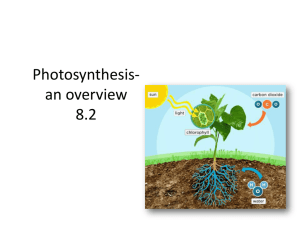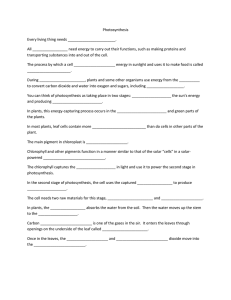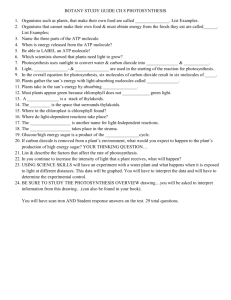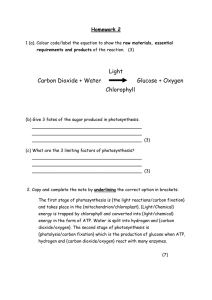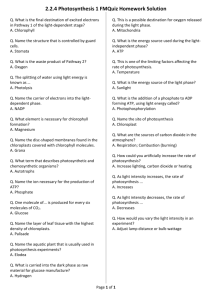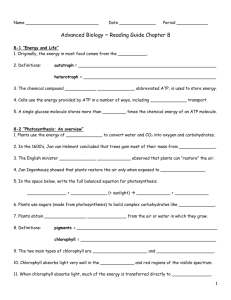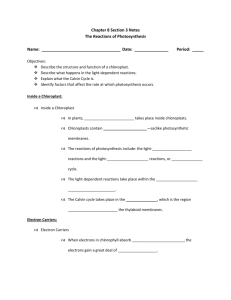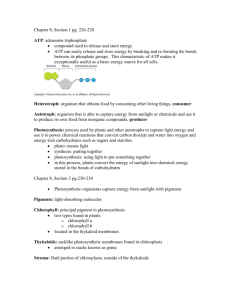Study Guide "Chapter 8 Photosynthesis" 8–1 Energy and Life Plants
advertisement
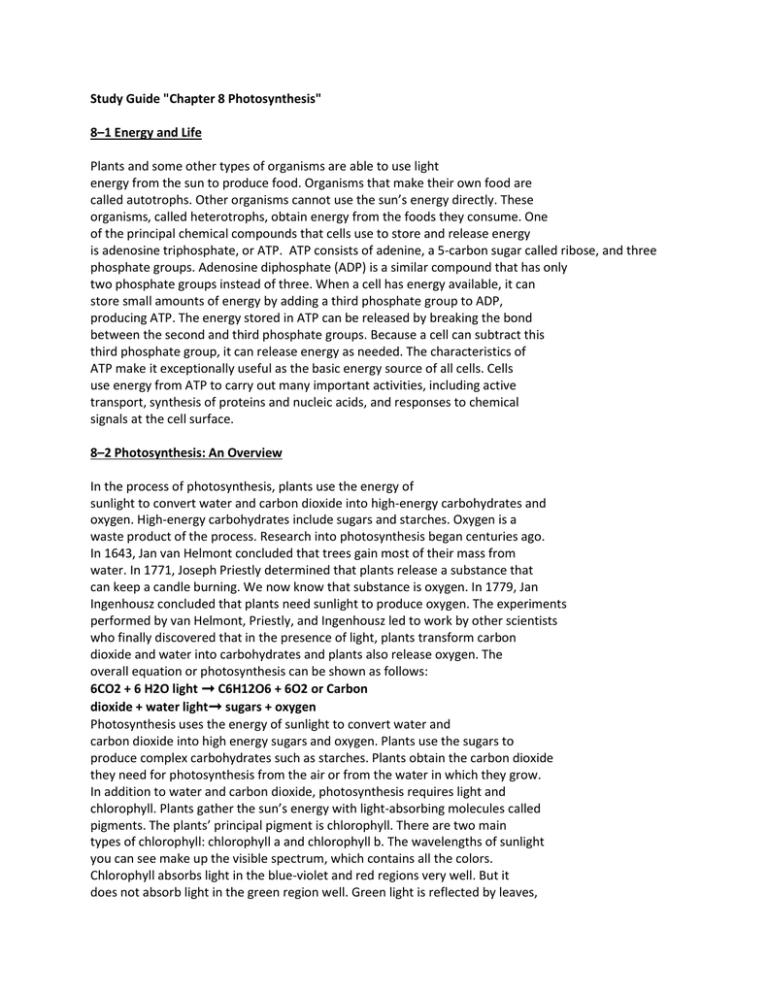
Study Guide "Chapter 8 Photosynthesis" 8–1 Energy and Life Plants and some other types of organisms are able to use light energy from the sun to produce food. Organisms that make their own food are called autotrophs. Other organisms cannot use the sun’s energy directly. These organisms, called heterotrophs, obtain energy from the foods they consume. One of the principal chemical compounds that cells use to store and release energy is adenosine triphosphate, or ATP. ATP consists of adenine, a 5-carbon sugar called ribose, and three phosphate groups. Adenosine diphosphate (ADP) is a similar compound that has only two phosphate groups instead of three. When a cell has energy available, it can store small amounts of energy by adding a third phosphate group to ADP, producing ATP. The energy stored in ATP can be released by breaking the bond between the second and third phosphate groups. Because a cell can subtract this third phosphate group, it can release energy as needed. The characteristics of ATP make it exceptionally useful as the basic energy source of all cells. Cells use energy from ATP to carry out many important activities, including active transport, synthesis of proteins and nucleic acids, and responses to chemical signals at the cell surface. 8–2 Photosynthesis: An Overview In the process of photosynthesis, plants use the energy of sunlight to convert water and carbon dioxide into high-energy carbohydrates and oxygen. High-energy carbohydrates include sugars and starches. Oxygen is a waste product of the process. Research into photosynthesis began centuries ago. In 1643, Jan van Helmont concluded that trees gain most of their mass from water. In 1771, Joseph Priestly determined that plants release a substance that can keep a candle burning. We now know that substance is oxygen. In 1779, Jan Ingenhousz concluded that plants need sunlight to produce oxygen. The experiments performed by van Helmont, Priestly, and Ingenhousz led to work by other scientists who finally discovered that in the presence of light, plants transform carbon dioxide and water into carbohydrates and plants also release oxygen. The overall equation or photosynthesis can be shown as follows: 6CO2 + 6 H2O light ➞ C6H12O6 + 6O2 or Carbon dioxide + water light➞ sugars + oxygen Photosynthesis uses the energy of sunlight to convert water and carbon dioxide into high energy sugars and oxygen. Plants use the sugars to produce complex carbohydrates such as starches. Plants obtain the carbon dioxide they need for photosynthesis from the air or from the water in which they grow. In addition to water and carbon dioxide, photosynthesis requires light and chlorophyll. Plants gather the sun’s energy with light-absorbing molecules called pigments. The plants’ principal pigment is chlorophyll. There are two main types of chlorophyll: chlorophyll a and chlorophyll b. The wavelengths of sunlight you can see make up the visible spectrum, which contains all the colors. Chlorophyll absorbs light in the blue-violet and red regions very well. But it does not absorb light in the green region well. Green light is reflected by leaves, which is why plants look green. Any compound that absorbs light absorbs the energy in light. When chlorophyll absorbs sunlight, much of the energy of the light is transferred directly to the electrons in the chlorophyll molecule, raising the energy level of the electrons. 8–3 The Reactions of Photosynthesis In plants and other photosynthetic prokaryotes, photosynthesis takes place inside the chloroplasts. Chloroplasts contain saclike photosynthetic membranes called thylakoids. Thylakoids are arranged in stacks called grana. Proteins in the thylakoid membrane organize chlorophyll and other pigments into clusters known as photosystems. These photosystems are the lightcollecting units of chlorophyll. The reactions of photosynthesis occur in two parts: (1) the light-dependent reactions and (2) the light-independent reactions, which is also called the Calvin cycle. When sunlight excites electrons in chlorophyll, the electrons gain a great deal of energy. A carrier molecule is a compound thatcan accept a pair of high-energy electrons and transfer them along with most of their energy to another molecule. One of these carrier molecules is NADP+. In the process of photosynthesis, NADP+ accepts and holds 2 high-energy electrons along with a hydrogen ion (H+). This converts the NADP+ into NADPH. The light-dependent reactions take place within the thylakoid membranes. These reactions require light. The light-dependent reactions use energy from light to produce oxygen gas and convert ADP and NADP+ into the energy carriers ATP and NADPH.
